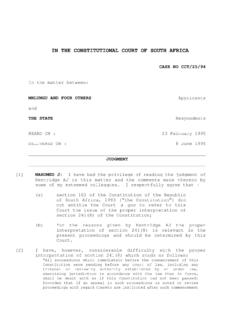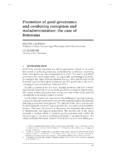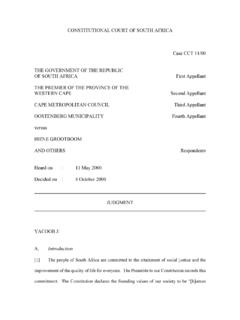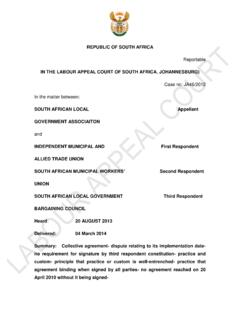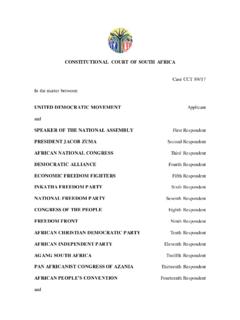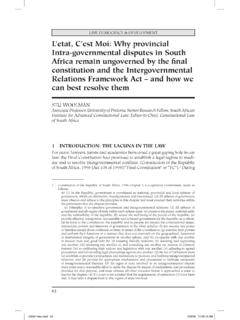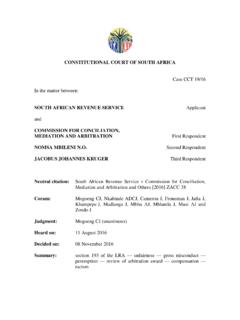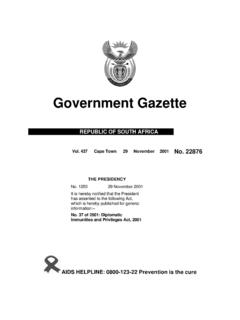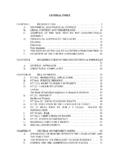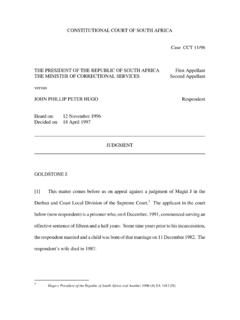Transcription of Transformative Constitutionalism and Customary Law
1 Transformative Constitutionalism and Customary Law Aninka Claassens* Geoff Budlender I IntroductIonThe late Chief Justice Pius Langa famously wrote:The Constitution is located in a history which involves a transition from a society based on division, injustice and exclusion from the democratic process to one which respects the dignity of all citizens, and includes all in the process of governance. As such, the process of interpreting the Constitution must recognise the context in which we find ourselves, and the Constitution s goal of a society based on democratic values, social justice and fundamental human rights . This spirit of transition and transformation characterises the constitutional enterprise as a in the constitutional era, Karl Klare wrote penetratingly about the legal work which has to be undertaken if the Constitution is to achieve its Transformative The work has to start with a questioning of the origins, underlying premises and purposes of the status quo law.
2 Martin Chanock has done this across a broad sweep of our law, in a book which has received insufficient attention from South African Andr van der Walt has undertaken a sustained and profound analysis in relation to property contestations over the dominant role afforded to officially recognised traditional leaders in respect of mining and investment ventures on communal land,5 and interventions by the Ingonyama Trust to convert indigenous ownership * Director, Land and Accountability Research Centre, Faculty of Law, University of Cape Town. Member of the Cape Bar; Extraordinary Professor of Public Law, University of Investigating Directorate: Serious Economic Offences v Hyundai Motor Distributors (Pty) Ltd; in re Hyundai Motor Distributors (Pty) Ltd & Others v Smit NO & Others [2000] ZACC 12, 2001 (1) SA 545 (CC), 2000 (10) BCLR 1079 (CC) stressed at para K Klare Legal Culture and Transformative Constitutionalism (1998) 14 South African Journal on Human rights 14 M Chanock The Making of South African Legal Culture 1902-1936: Fear, Favour and Prejudice (2001).
3 4 Van der Walt has written prolifically in this regard. See, eg, AJ van der Walt Property and Constitution (2012) 193 195. 5 A Claassens & B Matlala Platinum, Poverty and Princes in Post-Apartheid South Africa (2014) 4 New South African Review 113. See the discussion in A Manson & BK Mbenga Land Chiefs Mining: South Africa s North West Province since 1840 (2014) 155 160; S Mnwana Chief s Justice? Mining, Accountability and the Law in the Bakgatla-Ba-Kgafela Traditional Authority Area (2014) 49 South African Crime Quarterly 21; and B Matlala We Want the Bread not the Crumbs: Challenging Traditional Authority in the Platinum Belt (2014) 49 South African Crime Quarterly 31. 75 CONSTITUTIONAL COURT REVIEW vesting in families into leases,6 illustrate the pressing need for a comprehensive review of the impact of Transformative Constitutionalism on the Customary law. Since 2003 a range of laws have been enacted or proposed that bolster the power of traditional leadership in various ways.
4 The first was the Traditional Leadership and Governance Framework Act;7 the second was the Communal Land rights Act,8 which was struck down by the Constitutional Court in Repeated attempts to enact the controversial Traditional Courts Bill10 were thwarted by opposition to it by the majority of provinces in the National Council of Provinces i n 2 first part of this article looks at the great potential for transformation of the Customary law in the early judgments of the Constitutional Court. The second part reviews the work of the Constitutional Court on this project in 2013. Third, we look at further research which needs to be undertaken at this complex interface, at a critical historical moment. The fourth part asks questions about the place of Customary law in South African law: whether living law is a component of the transforming amalgam of South African law, or whether Customary law enables the maintenance of legal segregation for those living in the former of the questions which arise in relation to the transformation of the Customary law also apply to the transformation of the common law.
5 This article should not be understood as an argument for Customary law exceptionalism. Still, the Transformative project in respect of Customary law is distinctive. It requires at least the following steps:1 Recognise the Customary law as a consensual system of processes, practices and rules11 which govern the lives of millions of Recognise that the source of true Customary law is processes, practices and rules on the ground, which change over Recognise that, as Martin Chanock has shown, the insulation and separation of common law from Customary law under apartheid and colonialism was a key component of the overarching project of racial domination. Continuing insulation reinforces the segregationist ideal of different legal regimes for different categories of people. That is very different from the conception 6 Ingonyama Trust Board (2014) Annual Report 2013-2014 Briefing to the Portfolio Committee on Rural Development and Land Reform at 16 7, available at Act 41 of 2003 (Framework Act).
6 8 Act 11 of 2004 (CLRA).9 Tongoane and Others v National Minister for Agriculture and Land Affairs and Others [2010] ZACC 10, 2010 (6) SA 214 (CC), 2010 (8) BCLR 741 (CC).10 B 15-2008 and B See S Roberts & J Comaroff Rules and Processes: The Cultural Logic of Dispute in an African Context (1981); J Comaroff Rules and Rulers: Political Processes in a Tswana Chiefdom (1978) 13 Man - The Journal of the Royal Anthropological Institute 1 at 2; and Shilubana and Others v Nwamitwa [2008] ZACC 9, 2008 (9) BCLR 914 (CC), 2009 (2) SA 66 (CC) at paras 61, 65 and The teaching and practice of the law generally show little acknowledgment of the relevance of Customary law values to most South Africans. Blindness to the self-referential privileging of imported legal constructs at the expense of Customary repertoires that remain strong despite decades of state distortion, has material consequences for law s legitimacy and its of indigenous law in Alexkor as a system which feeds into, nourishes, fuses with and becomes part of the amalgam of South African law.
7 134 Interrogate the official versions of Customary law which we have inherited the cases decided by the courts under colonialism and apartheid, the legislation imposed by successive governments, and the writings in the textbooks on which the courts rely. We have to ask: What is the social and political function of these versions, and to what extent do they reflect the true Customary law?5 Apply this analysis not only to the so-called private law relationships under Customary law, but also to the sources and content of the authority of traditional leadership under Customary tranSformatIon of Customary Law prIor to 2013 Before one looks at the 2013 judgments, one has to take stock of how far this project had progressed in the Constitutional Court by that aside the Certification judgment, it took a surprisingly long time for Customary law to reach the Constitutional The first two cases were the 2003 Alexkor case,16 which addressed Customary land rights , and the 2004 Bhe case,17 which addressed Customary succession and the inheritance rights of women and children.
8 In those cases, the Court laid down five far-reaching , Customary law is subject to the Constitution. It has to be interpreted in light of the That might seem self-evident, but at the time it was , Customary law must not be viewed through a common-law Again, that may seem obvious to some, but it is far from apparent to many lawyers and particularly common-law , Customary law evolves and develops to meet the changing needs of the community. This recognises Customary law as living law .20 The notion that a system of law is not static, not inscribed in a book, and must not be vitrified, is a powerful tool in the process of , while Customary law can be established by reference to writers on the subject, caution has to be exercised when dealing with textbooks and old authorities, 13 Alexkor Ltd and Another v The Richtersveld Community and Others [2003] ZACC 18, 2004 (5) SA 460 (CC), 2003 (12) BCLR 1301 (CC)( A l e x k o r ) at para Customary law illustrates vividly the political and conceptual difficulties which are inherent in the public-private divide.
9 Our use of the term private in this context should not be understood to reflect an endorsement of the Ex parte Chairperson of the Constitutional Assembly: In re Certification of the Constitution of the Republic of South Africa, 1996 [1996] ZACC 26, 1996 (4) SA 744 (CC), 1996 (10) BCLR 1253 (CC).16 Alexkor (note 13 above).17 Bhe and Others v Magistrate, Khayelitsha, and Others [2004] ZACC 17, 2005 (1) SA 580 (CC), 2005 (1) BCLR 1 (CC).18 Alexkor (note 13 above) at para Ibid at para 5520 Ibid at paras 52 3; Bhe (note 17 above) at paras 109, 154 and This observation is of course not limited to Customary law: The same applies to common law, which also develops over Constitutionalism AND Customary LAW 77 CONSTITUTIONAL COURT REVIEW because they often distorted the true Customary This distortion goes beyond the tendency to view indigenous law through the prism of legal conceptions that were foreign to it.
10 The distortion also arose from political assumptions and purposes which were dominant under colonialism and apartheid,23 from a failure to understand the true nature of the phenomenon which was being observed, and from a failure to appreciate the changing nature of Customary law. The Court in effect said: Do not rely unthinkingly on old decisions, they may be wrong . That is a radical step. Courts usually look backward, to precedent, to find out what the law is today. The justification for reliance on precedent is that it creates certainty or at least predictability but it is also conservative in its Now we had the Court saying that as far as Customary law is concerned, precedent should be used with caution, because looking backward can entrench past , the judgments build on and take forward the Court s contextual approach to the realisation of rights , which foregrounds the real-life effect of poverty and inequality in people s This is stressed in various Constitutional Court judgments, including Zondi,26 Dawood,27 Mohlomi,28 and Minister of Home Affairs v The contextual approach to legal reasoning was pivotal to the Court s finding in Alexkor that the Precious Stones Act30 was discriminatory because of its effect, notwithstanding its racially neutral language.
